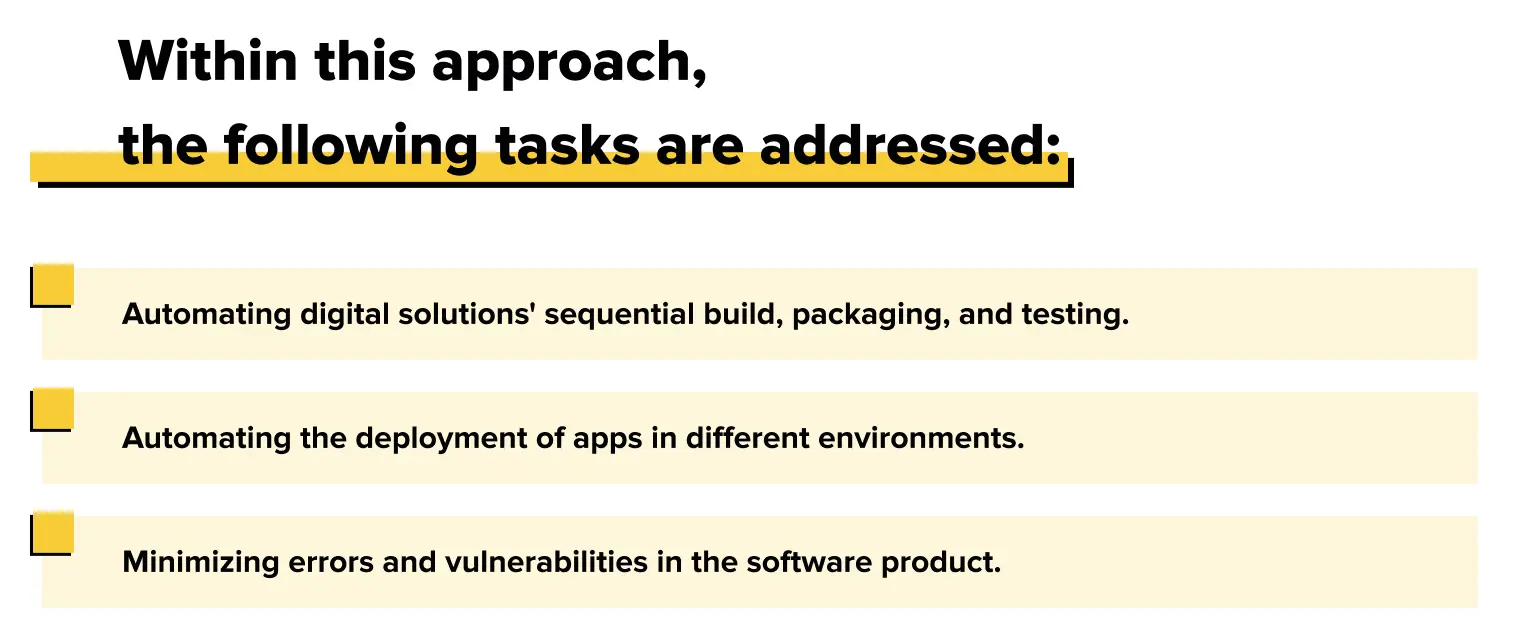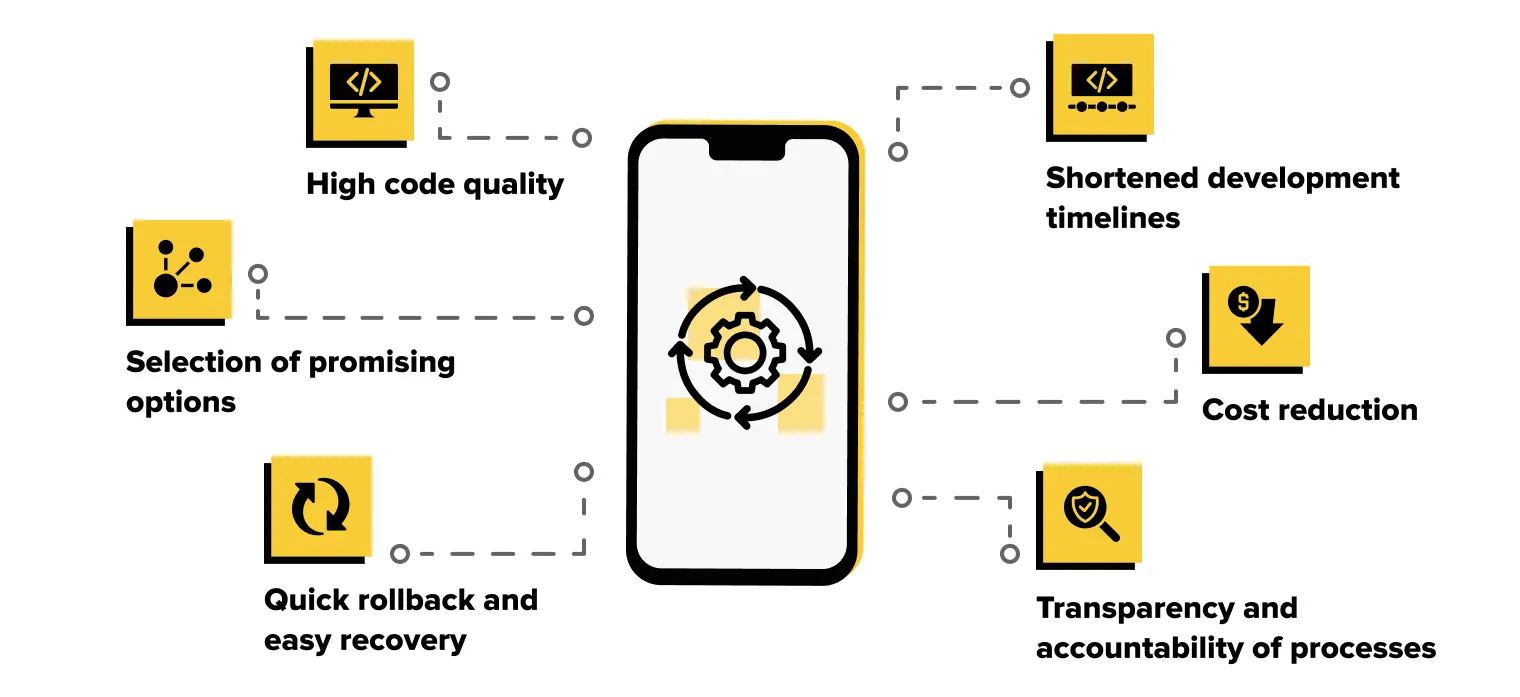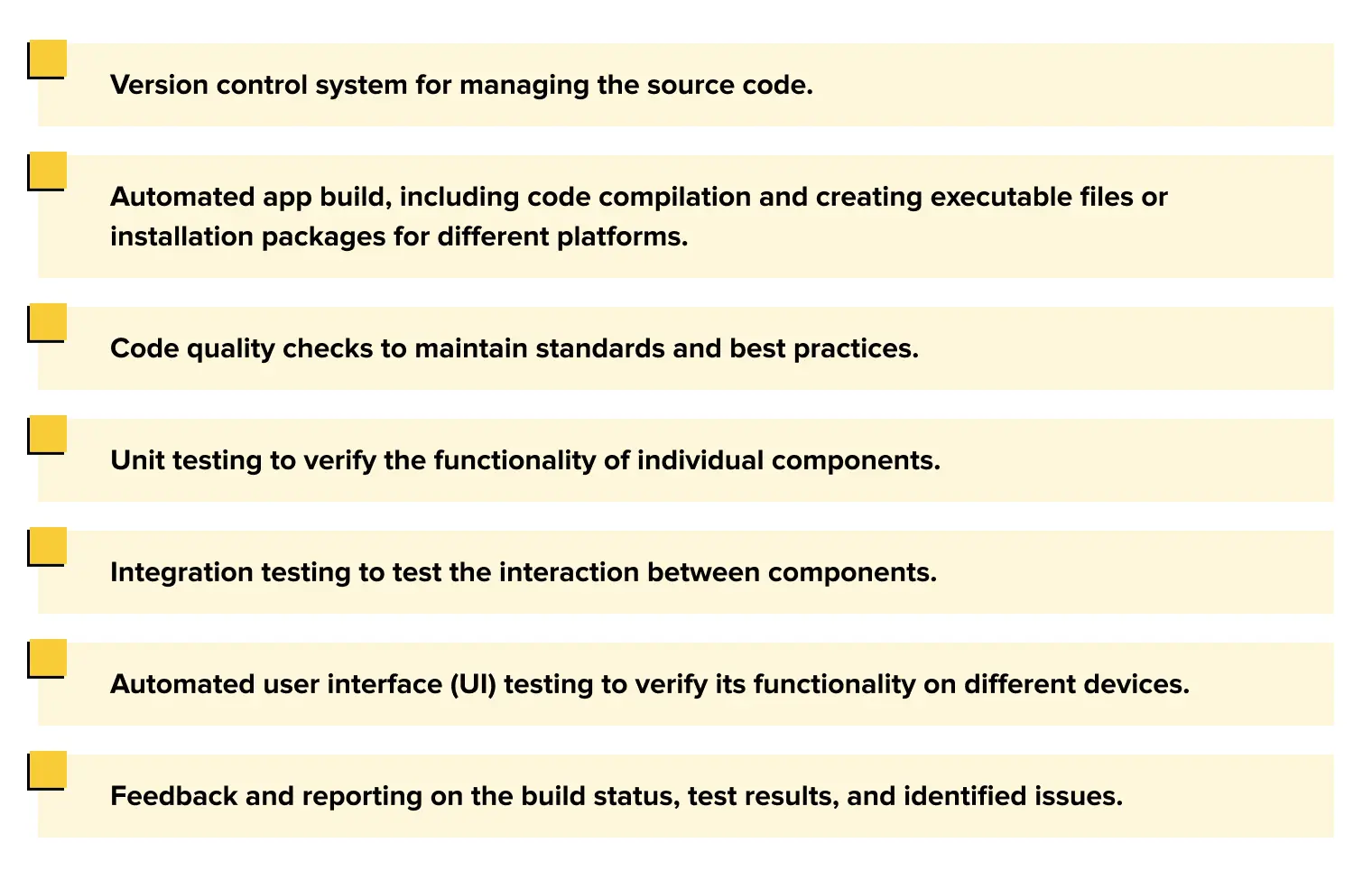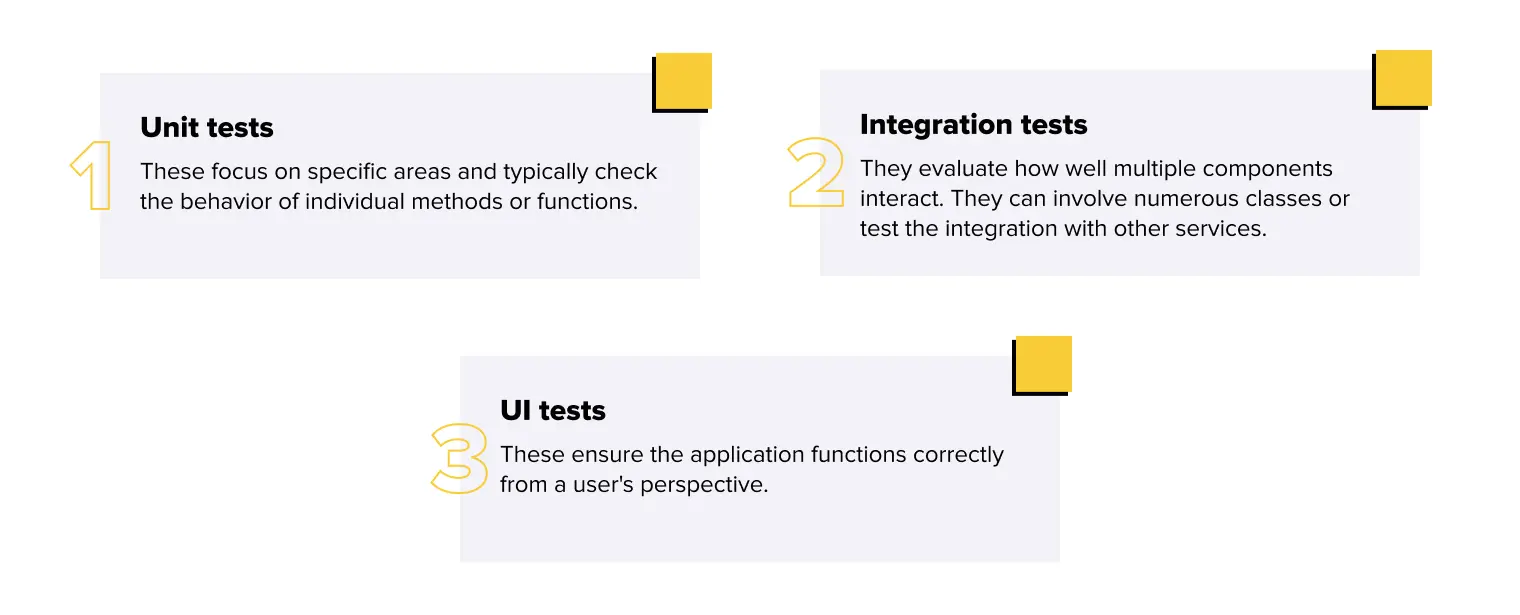Mobile phones have become an essential part of our everyday life. According to Statista, as of 2023, there are approximately 5.3 billion smartphone users worldwide. The global number is projected to increase and reach 6.2 billion by 2028.
Based on eMarketer's research, in 2020, mobile users spent around 4 hours per day on the Internet. Mobile apps accounted for 88% of the total time, while web browsers made up the remaining 12%. This demonstrates why there is a growing demand for mobile app development services for smartphones and tablets year after year.
Having a well-structured and easily accessible native iOS and Android app available on the App Store and Google Play can enhance the digital engagement of your business, leading to improved customer loyalty and increased sales.
Companies strive for maximum process automation in highly competitive markets, where the speed of delivering changes often plays a crucial role in the battle for customers. In mobile app development, there are practices where releases occur much more frequently than in traditional Agile processes. In such cases, continuous integration for mobile apps becomes indispensable.
What is continuous integration, what problems does it solve, and is it always necessary? The experts at Lampa Software will answer these and many other questions in this article.
Importance of Continuous Integration (CI) In Mobile App Development
The buzz around continuous integration for mobile apps is growing day by day. Regardless of whether they are involved in development, every organization should consider implementing it. Continuous integration has become the cornerstone of creating, testing, and deploying modern software products, meeting the expectations of a dynamically changing business environment.
The concept of continuous integration is part of Agile software development methodologies. Its main goal is to give sufficient attention to the final product's business requirements, security, and code quality.

CI helps expand the workforce and increase the efficiency of engineering teams. Its implementation allows app developers to work independently on different features in parallel. This enables them to integrate these features into the final product autonomously and without delays.
CI is an important and reliable technology used by modern organizations that value efficiency and quality in mobile app development.

Overview of the Benefits of CI for Mobile App Development
CI offers numerous benefits for mobile DevOps. Let's explore the main reasons for implementing this technology:
High code quality: With CI automating testing, developers can quickly identify and fix code issues. This reduces the likelihood of accumulating problems during the release stage, enhancing the app's overall quality.
Shortened development timelines: The methodology reduces the time for refinements to a few days or, in complex projects, weeks. This enables developers to quickly explore and test innovations, allowing them to implement them into the product ahead of competitors.
Cost reduction: When human intervention is minimized in the software development process, time and, consequently, money are saved. This is why automation is a key successful practice in DevOps. CI automates the transfer, source code management, version control, deployment mechanisms, and a significant portion of testing.
Quick rollback and easy recovery: CI enables developers to promptly restore a malfunctioning app. It is a simple process of rolling back the code to a previous state when problems arise. In other words, if deployment is planned across multiple environments, CI tools retain a history, allowing for a return to any previous version.
Transparency and accountability of processes: CI makes mobile app development transparent to clients through continuous feedback. They can instantly check the project status and, if needed, have control over its execution.
Selection of promising options: Rapid testing and many iterations enable developers to weed out unpromising code options early. This also facilitates the efficient use of time and resources by avoiding investments in unprofitable directions.
As we can see, CI saves time and money to such an extent that it enables developers to focus on tasks that are typically challenging. For example, revisiting and improving old code, making it cleaner and more efficient.
Understanding Continuous Integration
Mobile app development is an industry where the design, building, and testing stages must be as fast as possible. Instead of taking months for each phase, the clock is ticking in hours and even minutes.
That's why in 1991, Grady Booch, an American programmer and future recipient of the "Computer Pioneer" award, proposed an alternative concept called Continuous Integration. It was ahead of its time and has become the most well-known practice among developers worldwide.
Definition of continuous integration and its principles
CI is a methodology that frequently builds and tests an app to identify errors early in the SDLC. In simple terms, every time a programmer wants to change the project's shared code, they are picked up by the version control system, added to the project build, and merged with the main development branch.
After each merger, which happens multiple times daily, the system automatically builds and checks the new code components. Thus, CI eliminates human involvement in the build and deployment processes.
CI adheres to the following principles:
Responsibility distribution: Tasks and development stages are divided among team members or subgroups (for larger projects). The workflow is organized considering business logistics, implementation of cross-cutting features, conducting tests, data storage security, and more.
Risk reduction: Every developer or development team should strive to minimize vulnerabilities and bugs at all stages. This is achieved through continuous monitoring of business logistics, user testing, data storage and processing optimization, and more.
Feedback optimization: The success of a project depends on how developers, clients, and users interact. This affects the speed of incorporating corrections and updates into the app. While building and testing can be automated, many other operations require human involvement. The number of intermediaries between clients, developers, and users is reduced to make the work more constructive.
Creating a collaborative environment: Developers need a shared workspace for convenient task execution. In addition to the main process branch, there should be a secondary branch where testing, adjustments, fault tolerance tracking, and other activities can be carried out more conveniently.
How CI supports collaboration and integration in mobile app development
The methodology promotes effective teamwork and synchronization of code changes through the following aspects:
Presence of a shared code repository: Ensures consistency of work, reduces conflicts, and helps maintain an up-to-date version of the code for the entire team.
Continuous feedback: Facilitates collaboration, allowing developers to respond quickly to issues and iteratively improve their work. It creates a culture of constant improvement and learning within the team.
Fast integration: Automation of integration minimizes the complexities of code merging and conflict resolution, fostering smoother interactions within the team.
Streamlined communication: Enables team members to stay informed about the project's development process, identify vulnerabilities, and effectively coordinate their efforts.
The key components of a CI pipeline for mobile apps
The key components of continuous integration for mobile apps include:

By using these components in a CI pipeline, IT specialists can enhance the efficiency and quality of mobile app development.
Automated Testing in Continuous Integration
The first step towards continuous integration is setting up automated testing.
Importance of automated testing in the CI process
To fully leverage the benefits of continuous integration for mobile, it's important to automate tests to run for every change made in the main repository.
We prefer running automated tests on each repository branch, not just the main one. This helps identify issues promptly and minimize team disruptions.
Types of tests to include in the CI pipeline (unit tests, integration tests, UI tests)
There are several types of tests, with the most common ones being:

Continuous Deployment and Delivery For Mobile App Development
Continuous Deployment and Delivery in mobile app development are key aspects that enable efficient and speedy delivery of software updates to end users. These practices enhance the traditional product development cycle by automating the processes of creation, testing, and release.
Definition of continuous deployment and delivery in the context of mobile app development
Continuous Deployment refers to the release process incorporating automated testing.
On the other hand, continuous delivery produces a product where changes in the code trigger an automatic build, testing, and preparation for the final release. It is a fundamental principle in modern application development. It expands on continuous integration by deploying all code changes, after the build stage, to a testing and/or production environment.
In implementing mobile solutions, these concepts entail the continuous automation of the build, testing, deployment, and delivery processes. This technology ensures fast and reliable app updates, reduces manual effort, and improves development quality.
Strategies for automating the deployment process for mobile apps
Automating the deployment process is a critical aspect of successful CI implementation. Here are some strategies to help automate this process:
Implementing a CI pipeline for automated building, testing, and deploying mobile applications.
Using version control systems to manage and track app source code changes.
Creating separate environments for development, testing, and production. Using deployment automation tools or virtual platforms to provide isolated environments.
Implementing backup mechanisms and the ability to roll back changes in case of unsuccessful deployments.
Configuring notification and alert systems to receive information on deployment status and test results.
Applying these automation strategies enables teams to establish an efficient continuous deployment and delivery approach.
Techniques for Optimizing Build Times in CI for Mobile Apps
Optimizing the build time in continuous integration mobile apps is crucial to ensure fast feedback cycles and an efficient development process.
There are various ways to reduce the build cycle. Let's consider some of them:
Utilizing caching mechanisms to store and reuse dependencies, libraries, and intermediate build artifacts.
Implementing incremental build strategies that only rebuild the parts of the codebase that have changed since the last release.
Breaking down the build process into smaller, independent tasks that can be executed in parallel.
Using tools specifically designed for working with mobile applications.
Optimizing the test suite to focus on critical and most important tests.
Reviewing the CI pipeline configuration and removing unnecessary steps or duplicate tasks.
Scaling the CI infrastructure based on the build process requirements.
Maintaining a well-organized codebase with a modular architecture and clear responsibility separation.
Applying these techniques will significantly reduce the build time in CI for mobile applications.

CI/CD Best Practices for Mobile App Development
Creating a CI/CD pipeline is not a one-time operation that can be forgotten afterward. Like the software being developed, CI/CD practices require an iterative approach: analyzing data and tracking progress helps improve the established CI/CD process.
Let's explore the best practices for continuous integration and deployment recommended for the pipeline.
Commit early and often: To simplify integrating changes from multiple contributors, it is advisable to publish small changes more frequently. Each commit triggers a set of automated tests that provide quick feedback. With regular commits, all mobile teams work with the same source data, making collaboration easier and reducing the need to resolve conflicts when merging large and complex changes.
Keep builds green: That is, in a releasable state. It's more efficient to address issues as they arise, enabling a quick release of changes in case any problems occur in production. If a build fails, the team should immediately focus on resolving the issue.
Build once: Rebuilding the app for different environments risks introducing inconsistencies. The team won't have certainty about the success of testing in previous stages. Therefore, it's important to use the same artifact throughout all the build pipeline steps (including the final production release).
Optimize tests: Start by running the tests that execute the fastest, allowing for early feedback. Longer-running tests should be performed when there is confidence in the build. As for manual tests, considering their time-consuming nature and colleagues' involvement, it's better to execute them after the automated tests have passed.
Clean up the environment: Over time, environments deviate from their initial configurations and start to differ. This means that tests run in different environments may produce different results. Static environments require maintenance, slowing testing and delaying the release process.
Monitor and analyze the pipeline: Like software, the build pipeline requires a feedback loop. By analyzing metrics collected by the CI/CD tool, potential issues and areas for improvement can be identified.
Conclusion
Continuous integration, delivery, and deployment are development technologies that have emerged from the DevOps movement. They enhance the efficiency of creating, testing, and releasing mobile software, allowing it to reach users faster than traditional methods.
A well-executed build pipeline empowers a team to quickly deliver a functional product to end users and receive timely feedback on the changes made.
Trust the development of your app to the experts at Lampa Software, who follow the CI and CD methodology. We understand the process's intricacies and utilize the best tools to create high-quality digital products.